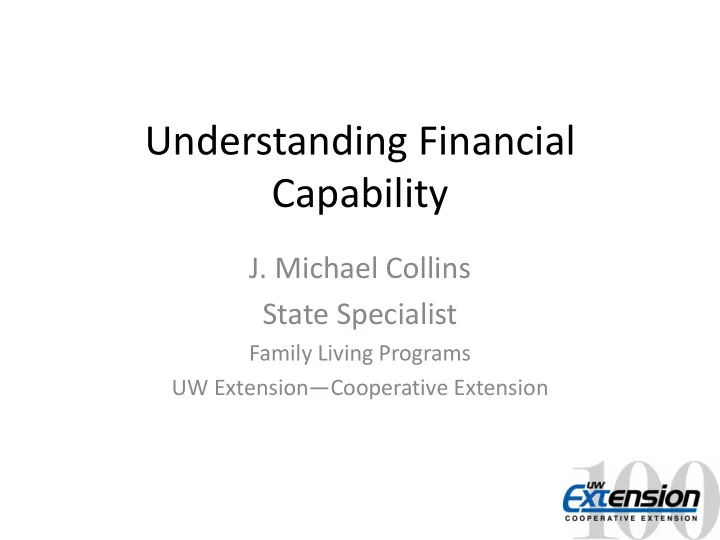

Understanding Financial Capability J. Michael Collins State Specialist Family Living Programs UW Extension — Cooperative Extension
From Financial Literacy to Financial Capability Financial Capability = The ability to… • Acquire resources • Evaluate options and decisions • Apply positive financial behaviors …throughout the lifespan in order to develop financial security.
• What a person • What a person knows about does with their positive money financial management knowledge Knowledge Action Financial Capability Influences Access • Factors that • Availability and contribute to use of appropriate beliefs, attitudes, financial products and behaviors and services
Financial Capability Survey for Wisconsin • www.usfinancialcapability.org - clickable map • Highlights: – 55 percent of Wisconsinites are living paycheck-to- paycheck (same as US average) – 57 percent of Wisconsinites do not have a rainy day fund to cover three months of unanticipated financial emergencies. (60 percent nationwide). – 19 percent used payday loan or similar (24 percent nationwide). – On average 3/5 financial literacy questions correctly (about average)
Table 1. Making Ends Meet and Planning Ahead Measure WI Nation Region Making Ends Meet Spending over the past year less than income 41% 42% 42% equal to income 38% 35% 36% more than income 17% 20% 18% Difficulty covering expenses and paying bills in typical month Very 16% 18% 19% Somewhat 43% 43% 42% Not at all 39% 36% 37% Large unexpected drop in income in past year 35% 40% 41% Overdraw checking account occasionally (has checking) 23% 26% 25% Late mortgage payments in past 2 years (has mortgage) One 7% 8% 7% More than one 10% 13% 13% Taking from retirement account in past year (has retirement plan) Loan 8% 10% 11% Hardship withdrawal 7% 8% 8% Planning ahead Have emergency funds to cover 3 months expenses 39% 35% 34% Ever tried to figure out retirement savings needs (non-retirees) 39% 37% 36% 35% 31% 30% Setting aside money for children's college education (have dependent children) Source: Summary of Selected Findings: Wisconsin, FINRA Investor Education Foundation.
Table 2. Managing Financial Products and Financial Literacy & Decision-Making Measure WI Nation Region Managing Financial Products Has checking account 91% 91% 90% Has savings account, money market, or CDs 79% 74% 74% Non-bank borrowing methods used in the past 5 years Auto title loan 7% 6% 5% Payday loan 9% 9% 9% Advance on tax refund (RAL) 4% 6% 6% Pawn shop 8% 12% 9% Rent-to-own 3% 7% 5% One or more non-bank borrowing method in past 5 years 19% 24% 21% Credit cards No cards 22% 24% 25% 1 card 17% 15% 15% 2 or more cards 58% 58% 57% Credit card use in past year | have credit card(s) Always paid in full 44% 41% 42% Carried a balance and was charged interest 55% 56% 56% Paid minimum only 35% 40% 39% Charged a late fee 21% 26% 25% Charged an over the limit fee 12% 15% 14% Took cash advance 12% 13% 12% Source: Summary of Selected Findings: Wisconsin, FINRA Investor Education Foundation.
Five Financial Knowledge Questions 1. Suppose you had $100 in a savings account and the interest rate was 2% per year. After 5 years, how much do you think you would have in the account if you left the money to grow? (more than, exactly, less than $102; don't know) 2. Imagine that the interest rate on your savings account was 1% per year and inflation was 2% per year. After 1 year, how much would you be able to buy with the money in this account? (more, same, less than today; don't know) 3. If interest rates rise, what will typically happen to bond prices? (rise, fall, stay the same; don't know) 4. A 15-year mortgage typically requires higher monthly payments than a 30- year mortgage, but the total interest paid over the life of the loan will be less. (true, false; don't know) 5. Buying a single company's stock usually provides a safer return than a stock mutual fund. (true, false; don't know)
Financial Decision-Making WI Nation Region 5 financial knowledge measures # correct out of 5 3.14 2.99 3.01 # "don't know" out of 5 1.11 1.21 1.20 Compared credit cards (has credit card) 37% 32% 32% Compared auto loans (has auto loan) 47% 44% 41% Obtained a copy of credit report in past year 39% 42% 41% Obtained credit score in past year 40% 41% 40% Source: Summary of Selected Findings: Wisconsin, FINRA Investor Education Foundation.
2012 Survey • Replicates many of 2009 surveys items • State-by-State Sample – Including Wisconsin • Also Military Sample • Added questions to measure level of financial education • Also sub-sample linked to American Life Panel – Should generate a host of new research studies
Financial Capability Strategies
Conclusions • Capability is different from literacy – Education still important, but more to the story • Be careful in terms of what people “should” do. • Overall well-being focus (finance is boring) – Wellness approach • Information can be helpful — but not always – Keep it simple – Goals, Intentions, Reminders • Context matters
More Information http://fyi.uwex.edu/financialseries/about/ Insights on current topics in financial education. THIRD Monday of the month at NOON.
Recommend
More recommend